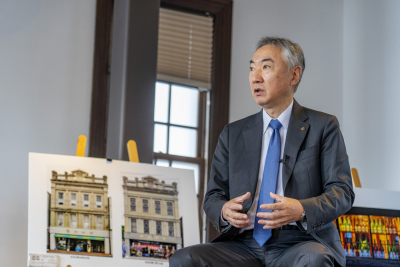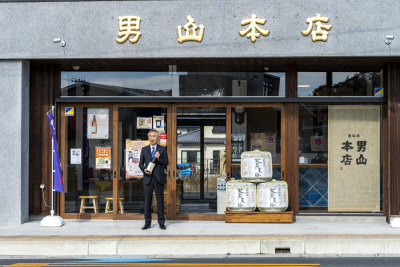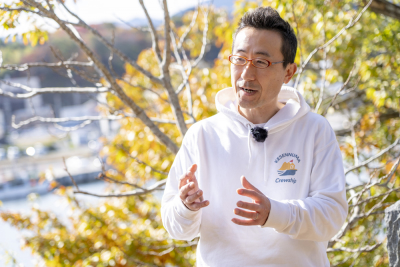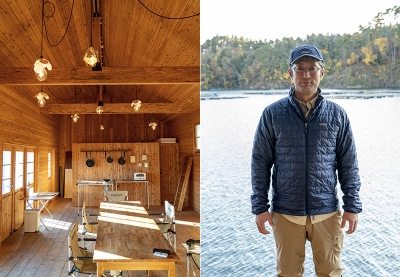A Respect for Nature and Life Alongside the Sea – Kesennuma Pride

Kesennuma City in Miyagi Prefecture is surrounded by sea and mountain, and its port has landed the largest volume of katsuo, or bonito, in Japan for 25 consecutive years. During the 2011 Tohoku earthquake, however, the area in and around the city suffered huge damage. Now, Kesennuma is transforming into an attractive city with new ambition. With the worldwide support,the development is thanks to locals who rediscovered their city’s attractions and developed a strong desire to the reconstruction, and new individuals from outside who sympathized with the city’s passions. Today, both born and bred locals and supporters from outside the city are working together to create an integrated regional model. Welcoming outsiders with open arms and respecting diversity—speaking to those engaged in the creation of a new Kesennuma has helped to shine a light on the strategies and ideas involved.
Unique Regional Characteristics
Located at the northeastern tip of Miyagi Prefecture and known for its rich fishing grounds and rias coastline, Kesennuma is one of Japan’s leading fishery regions. In 2003, Kesennuma declared itself Japan’s first “Slow Food City”, and in 2013, achieved the status of “Slow City” for the first time in Japan.
Akihiko Sugawara is chair of the citizens’ organization “Slow Food Kesennuma” and representative director and president of “Otokoyama Honten”, a traditional sake brewery in the city. One of the city’s leading advocates, Sugawara has been working to develop Kesennuma since before the Tohoku earthquake. Following the disaster in 2011, he has poured every effort into the city’s restoration,reconstruction and revivals of its industries.
“After the earthquake occurred, we received an unbelievably large number of messages of support and assistance. As I’ve worked to rebuild the region, I have always had a strong desire to somehow return this thanks,” says Sugawara. Kesennuma has a long history to live with the sea. Moreover, Japan’s fishery places significant value on nature’s blessings, ensuring that no part of the catch goes to waste. This way of life and approach to nature is the very definition of a sustainable lifestyle. Sugawara believes that disseminating the Kesennuma’s regional circular economy model to the world will help to express the city’s gratitude for the support we received.
He continues, “However, it’s important that this circular model is not a one-off measure for post-disaster reconstruction. We have to launch various initiatives that lead to a successive chain of new projects. As locals,we must promote these projects. Creating a system that supports this chain is essential.” Sugawara’s ambitions and ideas have brought supporters to come to Kesennuma toccreate new Kesennuma.
Inheriting Ambition and Hope
【Kesennuma Regional Growth Strategy, Inc. 】【Recruit Co., Ltd.】
Motoo Komatsu joined the Tohoku Future Creation Initiative put together by the Japan Association of Corporate Executives in 2013, and is currently the chairman and secretary-general of the Kesennuma Regional Growth Strategy, Inc. where he is in charge of marketing and business creation efforts. Komatsu attended school in Kesennuma but left to live elsewhere after graduating. Following the disaster in 2011, he decided to move back home. To revitalize the area through reconstruction efforts, Komatsu has set up a DMO (destination management organization) and worked on regional marketing activities. One particular favorite activity of his has been the launch of the “Kesennuma Crew Card”, a smartphone app.
“Kesennuma has always been a city focused on its fishing industry, and has never really prioritized tourism. As such, while it is of course important to ensure continued improvement of the resources that Kesennuma has, I thought it would be essential to create a tourism platform that could increase the number of people associated with the city. That is, one that could maintain links between visitors and the city itself,” says Komatsu.
The number of Kesennuma Crew Card members has since surpassed 46,000. The initiative has also garnered significant media attention as a successful Japanese example of customer relationship management in the tourism industry. Komatsu continues, “The aim is to have more people think about Kesennuma by connecting as many people to the city as possible. And of course, we hope that one day they develop a desire to visit us. Using the links between Kesennuma locals and those from outside, I hope that we can achieve continued regional revitalization.”
Living in temporary housing for around three years and ten months and working side by side with Komatsu was Naruhito Mori. Mori was sent out to Kesennuma by his company Recruit, and worked alongside Komatsu to fulfil his mission: rebuild the city following the disaster. While in Kesennuma, Mori helped to develop a range of products and services that communicate the attractions of the city, such as cosmetics using shark collagen and supplements made from special components found in krill. He also worked on the development of experiential sightseeing tours, such as oyster cultivation workshops led by local fishing guides and boat cruises around Kesennuma Bay. However, he realized that there was a lack of continuity in simply creating temporary products and businesses.
Mori says, “As I worked on reconstruction efforts in Kesennuma, I came to realize one of the exceptional qualities of the locals: they are incredibly receptive to various kinds of support. I knew that I would somehow have to enhance and utilize this quality. I therefore set up an organizational structure to promote collaboration with companies, to proactively welcome new residents from outside the city, and to encourage professional partnerships, for example. This ensured that anyone who expressed an interest could quickly access the relevant information and support. From now on, whenever new ideas come to the fore from within the city, we should be able to use internal resources to bring the ideas to fruition.”
Although Mori left his post in Kesennuma in 2021, as a Kesennuma Reconstruction Advisor and a close friend of Komatsu, his strong bond with the city continues to this day.
[Kesennuma Regional Growth Strategy, Inc.website: http://k-ships.com/ ]
Enhancing the Unique Attractions of Kesennuma 【Yamayo Suisan】【Otokoyama Honten】
Yamayo Suisan is an oyster farm in the Oshima Seto area of Kesennuma that has been in business since 1930. On April 29, 2022, the fourth-generation head of the company Takeshi Komatsu opened the Yamayo Shokudo oyster restaurant. His desire was to create a platform to link producers and consumers and allow guests to fully enjoy the taste of fresh oysters. The restaurant was also one of the filming locations for the Okaeri Mone TV series on the NHK television network. Komatsu took over the family oyster farm after leaving his role at a construction company. As a result of the Tohoku earthquake, however, he lost his home, his factory, and his farming facilities. His strong love for the abundant nature of the Oshima area and the fishing industry drove him to restart the business.
“Oyster farming begins in spring and the oysters are shipped out in the winter of the following year. In total, the process takes between 18 and 24 months. The sea around Kesennuma Bay is rich in minerals and full of the plankton that oysters feed on. This is why our oysters grow to such a large size. Of course, we cannot just leave them to grow. With the final form in mind, we keep an eye on their growth and make adjustments as necessary. This could be changing the location of the rafts, or immersing the oyster rafts in water of about 75°C atop a boat for a fixed amount of time to kill off any small shells or seaweed that have attached themselves to the oyster shells.”
Of course, working with nature means that you have to accept both successes and failures. But Komatsu is very particular about doing everything he can as a producer to ensure success. “When you work on the sea , you realize how lucky you are to work in such beautiful surroundings. It makes me really happy.” It’s clear to see from Komatsu’s expression his unwavering ambition and love for his hometown.
Itoe Kuboshima is the new, young chief brewer working at the Otokoyama Honten sake brewery. Born in Kanagawa Prefecture, Kuboshima studied brewing techniques at university, and a direct call to the brewery led to her being employed. Kuboshima says, “Drinking habits are changing and sake is growing in popularity across the world. In addition to further promoting sake consumption in Japan, I also want more people to learn about sake and its important place in Japanese culture.” Daisuke Kashiwa, the previous chief brewer at Otokoyama Honten, says, “While her skills are not completely refined yet, she has huge potential.” As interest in sake continues to grow, the brewery’s aim is to actively publicize and communicate details not only about its flavors, but also information on the people making the sake and the company itself. In November 2022, Otokoyama Honten released the first batch of Sotenden to be freshly brewed by Kuboshima after she took over the reins from Kashiwa.
Sotenden is a sake using features of the local climate. For the ageing process, Otokoyama Honten submerges bottles of Sotenden under the sea for one year. Although the process began as an experiment as the brewery explored new ways and places to store sake as an alternative to snow and low-temperature rooms, the method received wide acclaim for the unique taste it produced. Currently, the brewery is promoting Sea-Aged Sotenden as a product geared especially toward international visitors.
Sotenden brings together local rice, local water, local people, and the local climate. This unique story adds an additional charm to the drinking experience.
[Otokoyama Honten website: https://en.kesennuma.co.jp/ ]
[Yamayo Suisan website: https://yamayosuisan.com/ ]
Looking to the Future from Kesennuma 【Mori wa Umi no Koibito】【Usufuku Honten】
Mori wa Umi no Koibito (translated as “The forest is longing for the sea, the sea is longing for the forest”) is a non-profit organization based in Karakuwa Town in Kesennuma. More than 30 years ago, the organization began planting trees in the area to protect the sea. By planting trees on the mountains, which are valuable sources of water, the group is protecting and nurturing the region’s water environment. Makoto Hatakeyama is vice chairman of the NPO and involved in a wide range of activities. These include oyster and scallop production, environmental projects, collaboration with universities, and joint projects with overseas organizations.
Hatakeyama says, “After learning about environmental protection in Tokyo, I worked for a while on Yakushima Island before returning to my hometown in Kesennuma. By the disaster, I lost my home and my boats and so had to start from scratch. I wanted to check whether it was possible to restart oyster farming in the area, and so I asked a university researcher to conduct some safety checks. They gave me some scientific evidence that showed it was indeed safe to do so.”
Having experienced Kesennuma’s reconstruction following the disaster, Hatakeyama is already looking ahead to a new future for the city. One initiative he is working on is the communication of the area’s culture and lifestyle. Not only does this include the local satoyama lifestyles, biodiversity, and its forests and sea, but also an overarching view of its water environments and disseminate the culture and lifestyle to the world. He is therefore planning tourism programs through which visitors can learn about the local nature and ecosystems, as well as forest- and sea-based activities. “Whether it is overseas organizations, outdoor brands, or academic institutions, our efforts and communications have received strong support from numerous parties, and we are getting really solid feedback. Through our activities, one of our biggest goals is to contribute to the development of the regional economy,” says Hatakeyama.
Founded in 1882, Usufuku Honten is a local fishing company that owns seven Shofuku Maru longliners for tuna fishing. With bases in the Canary Islands in Spain and in South Africa, Usufuku Honten is mainly involved in deep-sea tuna fishing in the Atlantic and Indian oceans. Fifth-generation head of the company is Shotaro Usui, an individual who worked on the frontlines of post-disaster reconstruction.
“Through my experiences of the disaster, I came to once again realize and take huge pride in the unique fishing industry and food culture of Kesennuma. There are three key points that I want to communicate to the next generation,” says Usui.
The first is the importance of energy. “For around two weeks after the disaster , we lived with no power. I recognized once again that it is energy that brings convenience to our daily lives.”
The second is the importance of food. “Food and water are essential. Kesennuma is a city of food and boasts a fantastic food industry. We should all be much more confident in the city’s qualities.”
Third and finally is the importance of human connections. “The fishing industry, for example, is made up of fishermen, shipbuilders, ship repairers, and many other different people. The support of these individuals was invaluable in the reconstruction process. I therefore hope we can place even more importance on these connections.”
As the world’s values shift toward those in line with the SDGs and the achievement of sustainability, Usui believes that the Japanese fishing industry now has the opportunity to transform into a growth industry for the future. To date, among others, Usui has ensured thorough resource management (the company was the first Atlantic bluefin tuna fishing business to receive MSC certification), designed new boats with more comfortable working environments for those onboard, and educated local children on the importance of food and fishing. His aim for the future is to create a resource-friendly sustainable fishing industry. Usui’s goal is to transform Japan and the world through fishing. The fulfilment of this goal will no doubt have a major impact on the future of Kesennuma.
[Mori wa Umi no Koibito website: https://mori-umi.org/english/ ]
[Usufuku Honten website: https://usufuku.jp/ ]
Attracted by the City’s Charms and Launching Local Businesses 【Tsurukame Shokudo】【Black Tide Brewing】
The Tsurukame Shokudo dining hall opens at 7:00 in the morning just in time for local fishermen returning from their night’s work. All ingredients used at the restaurant are local. Tsurukame Shokudo is right in front of the local fish market. Open the door and you are met with a warm “Welcome back!” by the dining hall’s three female cooks. The trio met on a bus for disaster reconstruction volunteers heading to the affected zones, started to open Tsurukame Shokudo in 2019.
Ema Negishi from Tokyo is chairwoman of Kangei Produce. Upon visiting Kesennuma as a volunteer to help with reconstruction efforts at the age of 19, Negishi got to know a local fisherman. She was struck with admiration at his sense of mission to support and sustain the fishing industry, and decided to move to the area with a desire to work with fishermen like him.
Her idea was to set up a dining hall to warmly welcome back fishermen returning from long fishing trips, and two women who also volunteered in the area joined the project: Sachiwo Onotora, from Nara Prefecture, and Hirona Kato from Kanagawa Prefecture. A public bath was also set up next door so that the fishermen can get back to work feeling completely refreshed. “I want to make Kesennuma into a city that supports its fishermen more than any other,” says Negishi. Onotora and Kato, meanwhile, both say that have really felt the energy and enthusiasm of locals, and that they want to repay this with their own strengths and skills. The warmth and beaming smiles of the trio have become an irreplaceable charm for local fishermen.
Black Tide Brewing (BTB) was named after the Kuroshio Current, or the Black Current, that flows off the Sanriku coast, one of the world’s leading fishing grounds. With diverse product names and designs unique to Kesennuma and its port town status, BTB’s wide range of craft beers are incredibly popular and often sold out.
James Watney is BTB’s chief brewer. Hailing from Seattle in the US, Watney crossed over the Pacific to set up shop in Kesennuma. A theoretician with a PhD in chemistry, Watney moved to Kesennuma in 2019 with a strong desire to contribute to its reconstruction as a member of the community.
Kazuya Tanji, brewer and head of sales at BTB, says, “Our goal is to disseminate the diversity of craft beer to the people of Kesennuma and ultimately to those across Japan.” With links to overseas breweries and collaborations with breweries and local companies in Japan, BTB’s activities have garnered wide support and led to the development of close bonds, and the brewery continues to experience strong growth. Watney and Tanji’s activities are set to continue as they seek to widely distribute their made-in-Kesennuma products and highlight the appeals of Kesennuma to as many people as possible.
[Tsurukame Shokudo website: https://kesennuma-tsurukame.com/ ]
[Black Tide Brewing website: https://blacktidebrewing.com/en/ ]













